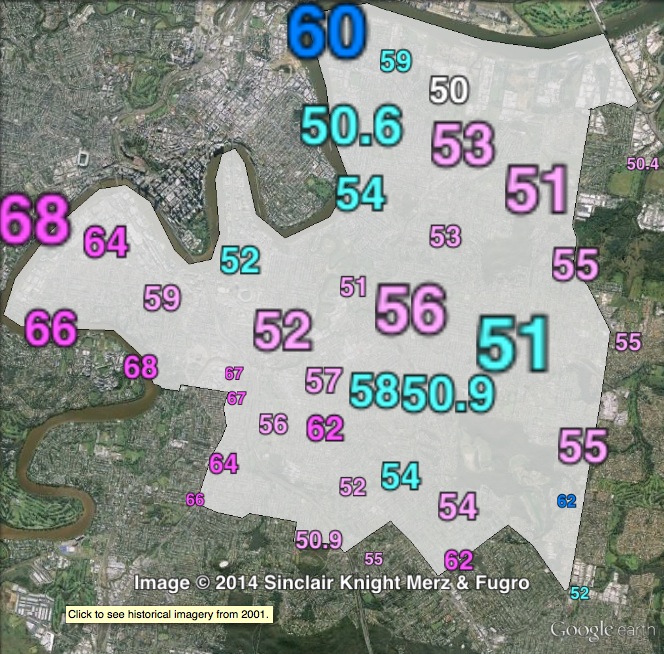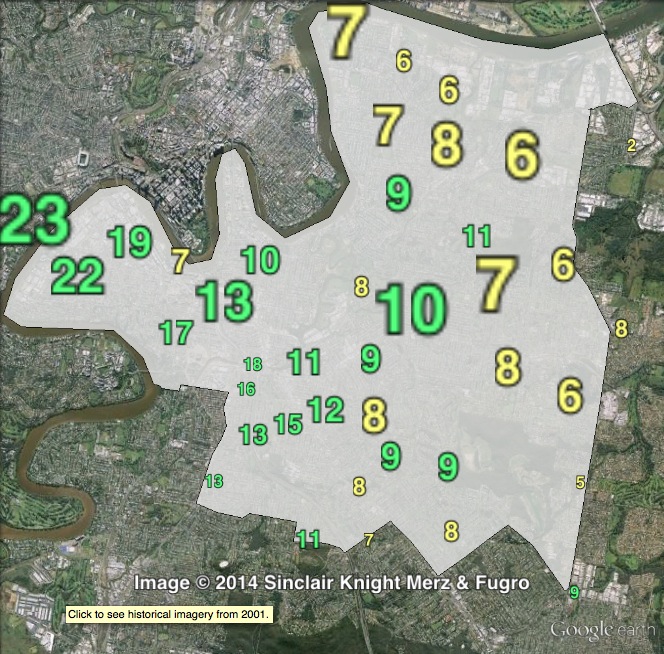At the end of election night we have some prepoll votes and all of the regular election-day booths. We’re still waiting on postal votes, as well as other pre-poll votes and possibly some special hospital booths.
These are the figures as of the end of election night:
Primary vote results as of 8:45pm – 40/40 booths reporting
| Candidate | Party | Votes | % | Swing | Projected |
| Timothy Lawrence | Stable Population Party | 570 | 0.83 | +0.64 | 0.86 |
| Geoff Ebbs | Greens | 6,890 | 10.09 | -0.09 | 10.12 |
| Christopher Williams | Family First | 650 | 0.95 | +0.21 | 0.99 |
| Karel Boele | Independent | 458 | 0.67 | +0.67 | 0.67 |
| Anthony Ackroyd | Bullet Train | 526 | 0.77 | +0.77 | 0.77 |
| Anne Reid | Secular Party | 380 | 0.56 | +0.56 | 0.56 |
| Terri Butler | Labor | 26,355 | 38.59 | -1.77 | 38.32 |
| Melanie Thomas | Pirate Party | 1,050 | 1.54 | +1.54 | 1.54 |
| Travis Windsor | Independent | 584 | 0.86 | +0.86 | 0.86 |
| Ray Sawyer | Katter’s Australian Party | 953 | 1.40 | +0.71 | 1.47 |
| Bill Glasson | Liberal National | 29,872 | 43.74 | +1.53 | 43.65 |
| Total formal votes | 68,288 |
Two-party-preferred results as of 8:45pm – 40/40 booths reporting
| Candidate | Party | Votes | % | Swing | Projected |
| Terri Butler | Labor | 35,380 | 52.33 | -0.68 | 52.23 |
| Bill Glasson | Liberal National | 32,232 | 47.67 | +0.68 | 47.77 |
| Total formal votes | 67,612 |
There were 40 booths that were used on election day. The ALP won a majority in 27 of these booths, with the LNP winning a majority in 12. A single booth saw an exact tie. In comparison the ALP won 29 out of 40 booths in the electorate in 2013.
Overall the ALP has suffered minor swings against it in most parts of the seat. The ALP vote increased in ten booths, and dropped in 30 booths. The worst swings were in Woolloongabba West (-23.2%) and Buranda West (10.3%), although the two Buranda booths were reorganised in a way that makes swings less reliable.
This swing against the ALP is not yet reflected in the raw results, as the postal votes will favour the LNP and are missing. Despite these votes, the ALP will hold on. I’m currently projecting the ALP to suffer a negative swing of just over 1%, but it’s hard to make a concrete projection considering how different special votes work in by-elections.
There was a slight swing to the Greens, and no minor party suffered a negative swing. The most successful minor party candidate was the Pirate Party’s Melanie Thomas, who has polled over 1.6% at the party’s first attempt in Griffith. The fifth place went to the KAP candidate.
The following booth breakdown uses the same booth breakdowns used for the pre-by-election guide.
| Voter group | GRN % | ALP 2PP % | ALP swing | Total votes | % of ordinary votes |
| Bulimba | 7.37 | 48.11 | -1.31 | 20,101 | 33.83 |
| Greenslopes | 10.56 | 54.78 | -0.06 | 19,196 | 32.31 |
| South Brisbane | 16.84 | 61.26 | +1.52 | 12,124 | 20.41 |
| East | 6.67 | 51.84 | -2.23 | 7,992 | 13.45 |
The ALP won a majority in three out of four areas. In the most populous part of the seat, Bulimba, the LNP won a slim majority in 2013 and increased this to 51.9% in 2014.
The ALP’s vote stayed steady in Greenslopes, dropped by 2.2% in the east, but went up by 1.5% in South Brisbane. South Brisbane was by far the strongest area, with the ALP gaining over 60% of the two-party vote, in part due to a very strong 16.8% for the Greens.
The following maps show the two-party-preferred (Labor vs LNP) vote, and the Greens vote.





Would have been a substantial swing to Labor and Greens if there weren’t such a dismal turnout. And if Glasson hadn’t so adamantly distanced himself from Newman and Abbott.
What dismal turnout?
On my analysis, the booths that had reported by the end of last night included 64,000 formal and informal votes. Those same booths at the last election included 63,000 formal and informal votes.
Of course the turnout will probably end up being down once you factor in that there will be no absent votes, which accounted for over 5000 votes in 2013, but I don’t think you can call it ‘dismal’.
Comments are closed.